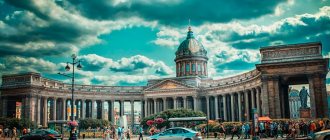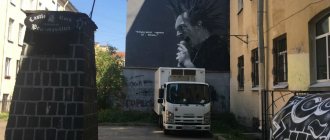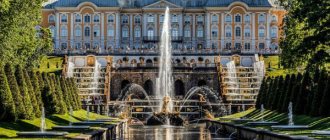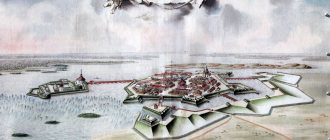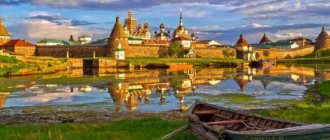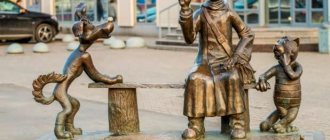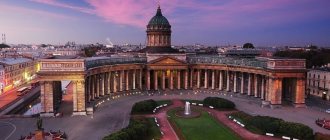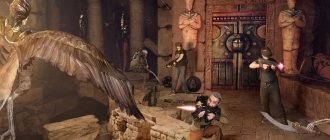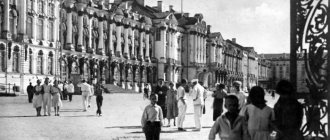St. Petersburg is a beautiful and extraordinary city that has a rich history. It attracts tourists with majestic buildings, extraordinary bridges, huge museum collections, and luxurious theaters.
In St. Petersburg you can visit so many things that your eyes will run wild from this variety. We will tell you about the most famous and interesting places in the cultural capital, namely, the sights of the center of St. Petersburg . By the way, we also have a detailed review of what to see in the city in 3 days and about unusual courtyards in St. Petersburg.
| to visit St. Petersburg after the pandemic , but you must wear masks and gloves in public places. Some city attractions operate with restrictions or are completely closed. We are sharing a list of current excursions that are already 100% POSSIBLE : a walk along rivers and canals with access to the Gulf of Finland, a night cruise on a boat under drawbridges, an unusual excursion along the roofs of St. Petersburg, a trip to Peterhof, Kronstadt and Fort Constantine with a guide. All of these excursions are available after quarantine without restrictions . |
Kazan Cathedral
- Address: St. Petersburg, Kazanskaya square, 2
- Opening hours: every day from 6:30 to 20:00
- the entrance is free
The Kazan Cathedral was built in 1801-1811. designed by architect Andrey Voronikhin. After the Patriotic War of 1812, the cathedral received the significance of a monument to Russian military glory. In 1737, the Kazan Icon of the Mother of God was brought to the temple. The cathedral was named “Kazan” after the icon it kept. Now it is one of the main attractions of the center of St. Petersburg. You can visit the temple either independently or with a guided tour, which takes place every day from 10:00 to 18:00.
St. PetersburgYandex.Maps - search for places and addresses, city transport
It is better to come to the Kazan Cathedral in the morning to feel the “sacral atmosphere” in silence. You can also attend the service and enjoy the singing of the choir. Before visiting the temple, you should turn off your phone. There is a dress code in the cathedral: you can visit the temple only in closed clothes, without a neckline. Women should also cover their heads. An unusual way to see the Kazan Cathedral is from the roof or with a city guide .
Transport
Air Transport
In the southern part of St. Petersburg, fifteen kilometers from the historical center, there is the territory of the Pulkovo International Airport. It has two terminals and is connected to the city by bus.
You can use the taxi order service at the dispatch center. Also in the airport building there are counters of car rental companies “Europcar”, “Sixt”, “Avis” and “Hertz”. You can also pre-book a Kiwitaxi transfer from the airport to your hotel or apartment.
Railway transport
Trains from St. Petersburg depart from five stations: Moskovsky, Finlyandsky, Vitebsky, Ladoga and Baltic. Of these, four (with the exception of Baltic) serve intercity routes and suburban routes. From here there are railway lines in the northern, eastern and southern directions, to Finland and Kazakhstan.
Moskovsky Station is the arrival point for high-speed trains from the capital. The trip takes only four hours. Finland Station serves express trains to Helsinki.
Sea and river transport
The city has a developed network of sea and river passenger transportation. The rivers and canals of St. Petersburg are filled with pleasure tourist boats and motor ships. Boat excursions can be found here.
Also, in the summer, popular urban transport runs along the city’s water network - aquabuses, which are river minibuses that run from Arsenalnaya Embankment to the Staraya Derevnya metro station and make several stops near the metro along the way. The city's maritime terminal is connected by ferry to Stockholm, Tallinn and Helsinki.
Metropolitan
The city metro has five lines, marked on the plan with different colors, and sixty-seven stations that open from 5:30 to 6:00 am and close from 0:00 to 1:00 am.
Public ground transportation
There are many bus, trolleybus and tram routes in St. Petersburg, as well as minibuses. The most developed type of ground transport is buses. In 2014, summer night routes were launched, operating from the beginning of May to the end of October. Currently, buses operate on five routes at night.
The public transport schedule at night depends on the bridge construction schedule during the river navigation season. Most bridges are opened between 1:25 and 2:20 am and from 5:00 to 5:45 am.
There are also a large number of taxi services and car rental points in St. Petersburg.
Church of the Resurrection of Christ (Savior on Spilled Blood)
- Address: St. Petersburg, Griboyedov Canal embankment, 2B
- Opening hours: from 10:30 to 18:00, day off – Wednesday
- Ticket price: adult – 350 rubles, children (from 7 to 18 years old) – 100 rubles, children (under 7 years old) – free
The Church of the Resurrection of Christ (Savior on Spilled Blood) recalls a tragic historical event - the assassination of Alexander II. Here in 1881 Ignatius Grinevitsky mortally wounded the Tsar. The cathedral was built in 1883-1907. designed by architects Alfred Parland and Archimandrite Ignatius. Initially, the temple was not a parish church; services dedicated to the memory of Alexander II were held there. Only in 1997 did the temple begin to receive visitors.
| To see all the sights of the center of St. Petersburg , book a tour on Tripster or Sputnik. Prices for group excursions start from 510 rubles, individual excursions start from 790 rubles. |
The cathedral has a rich mosaic collection. Mosaics are found not only on the walls, but also on domes and vaults. Ornamental and semi-precious stones were used to decorate the cathedral. The iconostasis contains the icons “The Mother of God and the Child” and “The Savior”. In the Church of the Resurrection of Christ, you cannot take photographs or talk loudly during services. By the way, you can take good photos of this landmark in the center of St. Petersburg from the Kazansky and Novo-Konyushenny bridges. Visiting the Church of the Resurrection of Christ is allowed only in closed clothes, without a neckline. Women should cover their heads. get acquainted with the Savior on Spilled Blood inside and outside on sightseeing tours Walk like a St. Petersburger and First acquaintance with the city .
Where to stay in St. Petersburg
Needless to say, St. Petersburg is the most popular city in Russia, and the guests have not been forgotten here. Tourists have a huge choice available: from a bed in a hostel to luxurious suites in premium hotels. Even in the city center, options can be selected to suit any budget, not counting the variety of its types and comfort. However, the closer you are to Nevsky, the faster options at an excellent price and quality are sorted out.
In addition to views of the main avenue, interesting offers include panoramic views of the Neva and bridges, St. Isaac's Cathedral, the Savior on Spilled Blood, the Admiralty and other postcard sites of the city. Among the wide range of housing, you can find not only standard apartments with parking, pets, a balcony or a kitchen in the apartment, but also palace, capsule, and two-level apartments. A convenient criterion for location and accessibility is the availability of the metro and direct routes of other transport.
- Hotels in St. Petersburg
- Hostels for Budget Travelers
- Flats and apartments
Interesting and useful selections are in the Tourister reviews. RU:
- Cheap hotels in the center of St. Petersburg
- Cheap hostels in the center of St. Petersburg
- SPA hotels in St. Petersburg and Leningrad region
- Recreation centers and hotels on the lakes of the Leningrad region
- Hotels near Pulkovo Airport
Cashback has become a part of our lives: you can use it to book accommodation on Booking.com: Cashback promotion on Tourist. RU
Photo: © Tatyana Lisker
Palace Square
- Address: St. Petersburg, pl. Palace
Palace Square is the main square of the cultural capital. The square represents the ensemble of the Winter Palace, the General Staff Building, the headquarters building of the Guards Corps, the Small Hermitage and the New Hermitage.
And the main decoration is the Alexander Column. It is dedicated to the victory of Russian troops in the war with Napoleon. At the foot of the Alexander Column there is the text “Grateful Russia to Alexander I.” You can get acquainted with the square on the Palace Petersburg .
Hermitage
- Address: St. Petersburg, Palace Square, 2
- Opening hours: Tuesday-Sunday – 12:00-21:00, day off – Monday
- Ticket prices: electronic entrance ticket - 500 rubles, Heroes of the Soviet Union, Heroes of the Russian Federation, full holders of the Order of Glory, children under 7 years old - free. You can buy a skip-the-line ticket using this link.
The Hermitage is the largest museum in the world. It consists of such departments as primitive culture, the ancient world, the history of Russian culture, the culture of the peoples of the East, numismatics, Western European art, works of decorative and applied art, and a graphic collection. The Hermitage contains many famous exhibits: “Madonna and Child” by Leonardo da Vinci, “Madonna and Child” by Raphael Santi, “The Return of the Prodigal Son” by Rembrandt van Rijn, “The Dance” by Henri Matisse.
The Hermitage is so large that it is impossible to get around it in one or several days. Due to the current epidemiological situation, the museum has created certain routes for which you can buy a ticket. Don't forget that this is one of the most visited attractions in St. Petersburg in the center. It is better to visit the museum in the morning, when there are not so many people. You can take one of the popular guided routes - an excursion into the world of art , a tour of the Hermitage , His Imperial Majesty the Hermitage , a tour of the Hermitage for children and adults .
Geographical position
St. Petersburg ranks second after Moscow in terms of population among cities in our country. It is the capital of the Leningrad region, located in the northwestern part of the European territory of the country, at the confluence of the Neva into the Gulf of Finland and occupies both banks of the river, dozens of islands and the shore of the bay.
The city was built on the site of a lowland formed as a result of the rise of the bottom of the prehistoric Littorina Sea. The altitude of the area in the central part of St. Petersburg is only two to three meters above sea level. The highest point - 176 meters - is located in Krasnoye Selo and is called the Dudergof Heights.
The bed of the Neva River is the main waterway of Northern Palmyra. Flowing into the Baltic Sea, it forms the Neva Bay in the Gulf of Finland. The Fontanka, Moika, Black River and Ekateringofka rivers flow into it through city canals and stone channels.
Approximately 40% of urban land is occupied by green space. St. Petersburg has a large number of gardens, parks, boulevards and public gardens. Outside the city, a vast area is covered with forests, consisting mainly of coniferous trees.
Everything that is useful for every tourist on a trip:
- You can find and book tours online at Travelata and Onlinetours.
- You can book and compare hotel prices on Hotellook. And the apartments are on Airbnb.
- You can choose the cheapest air ticket among all airlines on Aviasales, and a train ticket on Poezd.
- Find excursions around the world on Tripster.
- Buy insurance and not worry about your health at Cherehapa.
- Rent a car to see even more interesting places on Economybookings. Or a bike on BikesBooking.
- Book airport transfer Kiwitaxi.
(Visited 4,768 times, 7 visits today)
Nevsky Avenue
- Address: St. Petersburg, Nevsky Ave.
Nevsky Prospekt is the main street of St. Petersburg, where there are many attractions, museums, historical houses, cafes and shops. Nevsky Prospect starts from the bank of the Neva at the Admiralty and ends at the Alexander Nevsky Lavra. It is convenient to start the route from the Admiralteyskaya metro station.
Various events are often held on Nevsky Prospekt. Walking along the main street, you will see many famous sights in the center of St. Petersburg. We recommend visiting the Kuptsov Eliseevs store (Nevsky Prospekt, 56). This store sells various desserts, deli meats, spices, oils, and even black caviar. In addition to gastronomy, the store has a luxurious interior and unusual display windows. You can find out the secrets of Nevsky Prospect on an excursion with a St. Petersburger , a walk along Nevsky Prospect , a sweet route along Nevsky Bohemian Petersburg excursion .
How else to spend a weekend in St. Petersburg
You can come up with a wide variety of options for how to spend a weekend in St. Petersburg. You can devote both days to museums according to your interests, or go to famous country royal residences. Tourists can also experience the region's nature on a weekend getaway.
Museums
A weekend in St. Petersburg can be devoted to museums, which are represented by a wide variety. It is not for nothing that they say about the city that it has a special atmosphere that attracts creators and connoisseurs of art - from classics to avant-garde. Establishments are usually closed 1 weekday per week.
The first public museum was founded by Peter I - this is the famous Kunstkamera with anatomical and zoological rarities, as well as ethnographic collections.
Kunstkamera Photo: © Dmitry Roslik
Art museums are the famous Hermitage with masterpieces of world art, the Russian Museum with works of domestic masters from different times, the Erarta , as well as various palaces that house the collections of large museums. It will be interesting to see the interiors, made in different styles, at the Stieglitz Academy and its museum, go to the Museum-Institute of the Roerich Family or the Matyushin House - a museum of the St. Petersburg avant-garde . The Street Art Museum is dedicated to street art .
Street Art Museum Photo: © krissoln
The Museum of Urban Sculpture is engaged in the restoration and preservation of ancient cemeteries with valuable tombstones, at the Alexander Nevsky Lavra - this is the Necropolis of the 18th century. and Necropolis of Art Masters.
You can learn about different pages in the history of the city in the Museum of the Defense and Siege of Leningrad , in the museum on the cruiser Aurora , in the Museum of the History of St. Petersburg , etc.
The Museum of Music , the Museum of Theater and Musical Art , and the Museum-Apartment of F. Chaliapin are dedicated to the art of music and outstanding figures . Literary themes occupy a special place - in St. Petersburg there are museums of F. M. Dostoevsky , A. S. Pushkin , A. Blok , A. Akhmatova , the necropolis museum “Literary Bridges” , etc.
More details: museums of St. Petersburg
Museum of Urban Sculpture (necropolises at the Alexander Nevsky Lavra) Photo: © Tatyana Lisker
Suburbs
A day off in St. Petersburg is a good opportunity to visit the palace and park ensembles in the surrounding area, famous for their beauty. It is better to plan a visit to one suburb for 1 day. Among the most popular destinations:
- Peterhof . If you spend a weekend in St. Petersburg in May, you will already be able to see the stunning fountains (usually open from late April-May to October). The main fountain structure is the “Grand Cascade” ; excursions are even organized to the grottoes underneath it. In any season you can get to the luxurious Peterhof Palace ; there are other remarkable buildings on the territory of the complex. In the suburb there is also the Cathedral of the Holy Apostles Peter and Paul in the neo-Russian style, but, unfortunately, it will not be possible to see it now due to restoration forests.
Grand Cascade in Peterhof Photo: © Sergey Arkhipkin
- Tsarskoe Selo (Pushkin) is a museum-reserve with two magnificent palaces: Catherine and Alexandrovsky . They have picturesque parks of the same name with various pavilions. Pushkin is also home to the Imperial Tsarskoye Selo Lyceum , of which A. S. Pushkin is a famous graduate, and the poet's dacha museum .
- Palace with state halls, ancient sculpture and other works of art brought from Europe was built in Pavlovsk Pavlovsk Park is considered one of the largest landscape parks in Europe.
Other suburban destinations include Gatchina , Oranienbaum , Strelna . If you get to the suburbs by train, you will depart from the Baltic Station .
Detailed advice on what to see in St. Petersburg in 2 days
Pavlovsk Photo: © Nastenka Pavlik
Weekend hikes in St. Petersburg
Those who have visited the “northern capital” more than once and seen the main attractions may be interested in the option of active recreation. These can be either 1-day destinations or for both days. Such weekend tours in St. Petersburg will appeal to lovers of northern nature with forests and lakes.
You will see natural beauty while hiking in the Ladoga region . These can be hiking routes along the shores of Lake Ladoga and a pine forest, with climbs to the peaks of the mysterious mountains of Karelia and inspection of granite rocks. A common option is to go to Yastrebinoye Lake and walk along the suspension bridge. The road to this lake from the granite quarry in Kuznechnoye is called the “Ho Chi Minh trail” ; it offers picturesque views of rocks and other lakes.
Hiking to Yastrebinoye Lake Photo: © Anna Kuznetsova
Weekend trips in St. Petersburg are also offered by water - catamarans or kayaks on lakes, rafting on rivers. You can go by boat along the Vuoksa , a river on the Karelian Isthmus, the route lasts about a week, you need special equipment. Tours are organized in the Ladoga Skerries National Park of the Republic of Karelia, suitable for families with children. In winter you can ski here.
Thematic hikes are also organized to places associated with the war - old fortifications and battle sites. It is possible to travel by car through regional villages with abandoned estates or bike tours in the surrounding area.
Weekend in St. Petersburg with children If you are going on a trip with children, the city has a lot of entertainment and attractions that will interest the children. Check out the material on where to take your child in St. Petersburg
Ladoga skerries Photo: © Galina Gorshenina
Kunstkamera
- Address: St. Petersburg, Universitetskaya embankment, 3
- Opening hours: Tuesday – Sunday from 11:00 to 18:00, day off – Monday, sanitary day – last Tuesday of the month
- Ticket price: adult – 300 rubles, reduced price – 100 rubles
The Kunstkamera is the first Russian museum and the largest ethnographic museum in the world. The Kunstkamera was founded in 1714 by Peter I. In 1734, a new museum building was built. Peter I brought unusual exhibits from all over Russia that were of scientific value for the museum.
Now the Kunstkamera houses collections representing the life and culture of different countries and peoples: Japan, China, Mongolia, Africa, India, Indonesia, Australia. Also on display is the anatomical hall, which houses a collection of deformities and oddities. The Kunstkamera also has exhibitions dedicated to the first astronomical observatory of the Academy of Sciences and Mikhail Lomonosov. Everyone should visit this attraction in the center of St. Petersburg; it will be interesting for children and adults.
Russian Museum
- Address: St. Petersburg, st. Inzhenernaya, 4
- Opening hours: Monday - from 10:00 to 20:00, Wednesday, Friday, Saturday and Sunday - from 10:00 to 18:00, Thursday - from 13:00 to 21:00, day off - Tuesday
- Ticket price: adult – 450 rubles, reduced price – 200 rubles, children (under 16 years old) – free
The Russian Museum is the largest museum of fine arts. Its history begins in 1898. The museum's collection consists of about 400 thousand exhibits.
The Russian Museum houses many famous paintings: “The Last Day of Pompeii” by Karl Bryullov, “The Ninth Wave” by Ivan Aivazovsky, “Barge Haulers on the Volga” by Ivan Repin, “Moonlit Night on the Dnieper” by Arkhip Kuindzhi, “Merchant’s Wife at Tea” by Kustodiev, “The Last Supper” » Nikolai Ge and many others. The museum often hosts various exhibitions. You can take a guided tour on the topic of masterpieces of the Russian Museum , masterpieces of the Mikhailovsky Palace or the Benois Wing and the main paintings of the 20th century .
Saint Isaac's Cathedral
- Address: St. Petersburg, St. Isaac's Square, 4
- Opening hours: from 10:30 to 18:00, day off – Wednesday
- Ticket price: adult – 350 rubles, reduced price – 100 rubles, children under 7 years old free
St. Isaac's Cathedral is the largest Orthodox church in St. Petersburg, which has an interesting and rich history. Initially, St. Isaac's Cathedral was a wooden church, which was built in honor of the Byzantine monk Isaac of Dalmatia (his memorial day falls on the birthday of Peter the Great). St. Isaac's Cathedral was constantly changing. Instead of a wooden church, they made a stone one, then they built a new one, but it did not correspond to the main building. And only in 1818 did they begin construction of a new temple designed by the architect Auguste Montferrand. The cathedral turned out to be truly luxurious and monumental. It was given museum status in 1948. Since then it has been one of the main attractions of St. Petersburg in the city center.
Having visited the temple, you will see the luxurious decoration and feel the sacred atmosphere. But you can go beyond just visiting the cathedral and go up to the Colonnade, which offers beautiful views (tickets for the colonnade are sold separately). To get to the observation deck, you will have to climb 262 steps, so we recommend wearing comfortable shoes. Don't forget to wear warm clothes, as it can be windy on the Colonnade. You can relax after visiting St. Isaac's Cathedral and its Colonnade in the panoramic restaurant "Mansarda", which is located nearby. You can get acquainted with the architectural masterpiece on excursions to St. Isaac's Palace from the outside and inside , the entire center of St. Petersburg and St. Isaac's Cathedral .
In the center
Palace Square
Palace Square is the heart of St. Petersburg. There are always a lot of people there, and something happens both day and night. The project of the architectural ensemble was carefully thought out, so everything here looks harmonious: the Winter Palace, where the Russian emperors lived, the Alexander Column and the General Staff. In addition, Palace Square has more than once become the center of important historical events: the Revolution and popular demonstrations. Now the main city holidays and concerts take place here.
Winter groove
Not far from Palace Square behind the Winter Palace there is a small canal connecting the Neva and Moika. This is one of the most atmospheric and romantic places, especially beautiful in the evening. An arch spans over the canal between the Hermitage Theater and the Hermitage. The bridge over the ditch is sometimes unofficially called “Liza’s bridge,” since in the play “The Queen of Spades” by Tchaikovsky the heroine Liza throws herself from it.
Peter-Pavel's Fortress
The history of St. Petersburg began with the Peter and Paul Fortress and Hare Island, and the day the fortress was laid is considered the day the city was founded. Despite its defensive function, throughout history the fortress has never become a site of battle. In addition to the fortress walls and bastions, there is the Peter and Paul Cathedral, where members of the royal family are buried, a former political prison (now a museum), the Mint and the Museum of the History of St. Petersburg. There is also a beach where St. Petersburg residents often sunbathe at any time of the year.
Since the 18th century, there has been a tradition of firing a blank shot from a cannon at exactly noon - this tradition has survived to this day. In general, there is a lot of interesting things on the territory of the Peter and Paul Fortress; there are several unusual sculptures, including a disproportionate monument to Peter I and hares.
Opening hours: 06:00 – 21:00
Entrance to the fortress territory is free.
Arrow
From the Spit of Vasilyevsky Island, perhaps the best panorama of the main attractions opens. After the founding of the city, it was used as a port and trading area, and the Rostral Columns then served as lighthouses. Later, the concept of the Strelka changed, an architectural ensemble appeared with the Exchange in a classical style, and on the left and right sides of it were customs and warehouses, and a flat semicircular cape was built. Now there is a small garden and a descent to the Neva, and the Rostral columns are lit only on holidays.
Universitetskaya embankment
At the Strelka and the Palace Bridge, the University Embankment begins, which was one of the first to be built in the city.
Kunstkamera
The Kunstkamera is the first natural science museum in Russia, created by decree of Peter I. Now most of the museum is occupied by ethnographic exhibitions, but most of all the museum is famous for the Cabinet of Curiosities, where stillborn babies with developmental defects and other anatomical exhibits are stored.
Twelve Collegiums
Next is the building of the Twelve Colleges. The complex was built for government bodies in the Petrine Baroque style, and the buildings were occupied by various colleges. Now here are the faculties and libraries of St. Petersburg State University.
Menshikov Palace
Further along the embankment stands the palace of Menshikov, the main assistant of Peter I. Now there is a museum in the palace, where you can learn more about the life and work of the adviser in the first years after the founding of the city, as well as see the interiors of the 18th century.
Sphinxes
Near the Annunciation Bridge, Egyptian sphinxes from the 14th century BC stand on high pedestals. The sphinxes were purchased and brought to St. Petersburg from Egypt in the 19th century and became one of the most ancient monuments of the city. By the way, there are many sphinxes in the city, for example, on the Egyptian Bridge, and all of them are invariably surrounded by various legends.
Then you can cross to the opposite shore or continue your walk around the island: read about the sights of Vasilyevsky Island.
Bronze Horseman
On the other side of the Annunciation Bridge on Senate Square is one of the symbols of the city - the monument to Peter I. The large-scale sculpture of Peter on horseback was technically difficult to implement and took several years to create. The monolithic stone on which the rider stands was so heavy that its transportation from Lakhta took almost a year. The name “The Bronze Horseman” was not actually official - it was invented by Pushkin for the poem of the same name, but has now become more famous.
Saint Isaac's Cathedral
The most grandiose monument in St. Petersburg is St. Isaac's Cathedral, which is the fourth largest European cathedral. To create a project for the country's main Orthodox church, a competition was created, which was won by the young architect Auguste Montferrand. Construction began in 1819 and took forty years, becoming the main work of the architect’s life - Montferrand died a few months after the completion of the work. The implementation of the project was extremely difficult from a technical point of view: it required transportation and processing of dozens of types of stones, including granite and marble, work with toxic materials when painting interiors, construction at high altitudes - many workers died over the years.
St. Isaac's Cathedral remains one of the tallest buildings in the city, and its golden dome is sometimes visible even from outlying areas. After the revolution, the cathedral was deprived of its status as a church and is now a museum. Bombings during the war left chips on the façade. It’s definitely worth going inside, as the interior took more than sixteen years to create. In good weather, you should climb the colonnade - it offers a panoramic view of the central areas. However, keep in mind that you will have to climb on foot.
Opening hours: 10:00 – 17:30
Entrance - 350 RUR, closed on Wed.
Climb the colonnade - 200 RUR.
Admiralty
The Admiralty was built soon after the founding of the city, because the fleet and shipbuilding were extremely important for St. Petersburg. The original appearance of the building was quite simple, but was later rebuilt into a more magnificent one. Only the famous spire with the boat remained unchanged. It is difficult to imagine that it was once surrounded by meadows, which gradually turned into the modern Alexander Park. At the Admiralty, it is easy to trace the strict plan according to which the city was built: three main highways radiate from it: Nevsky Prospekt, Gorokhovaya Street and Voznesensky Prospekt.
Kazan Cathedral
Walking along Nevsky Prospekt, it will be difficult not to notice the Kazan Cathedral with its outstanding colonnade. The architecture clearly shows the influence of antiquity and classicism, and despite the fact that it is now a recognized monument, the implementation of the project was often criticized by contemporaries. The exterior and interior were created from a variety of natural stones, and the walls were painted by famous masters and artists, including Karl Bryullov. The Kazan Cathedral was the wedding venue for members of the royal family. In Soviet times, as part of anti-church propaganda, a museum of religion and atheism was located here. Now this is the St. Petersburg Cathedral.
Opening hours: 06:30 – 19:45
Free admission
Savior on Spilled Blood
The cathedral stands on the site of the assassination of Alexander II, and its gloomy name is connected with this event. It was built in the Russian style, while the architects do not deny the influence of Moscow's St. Basil's Cathedral. You can spend a long time looking at the decorative details of the facade, multi-colored domes, platbands with kokoshniks and picturesque panels, but you definitely need to go inside, because all the walls and ceilings are covered with mosaics.
It was the mosaic design that delayed the opening of the cathedral for several years. Almost the entire interior is covered with mosaics based on sketches by great Russian artists on fairy-tale, historical and biblical themes.
Now it is difficult to imagine that in Soviet times the church was used for a long time as a warehouse, and then as a morgue. Fortunately, it is now a museum and the façade and interior have been completely restored.
Opening hours: 10:30 - 18:00, closed on Wed.
Entrance - 350 RUR.
Singer House
The House of Books - or the Singer House - is the most expressive example of Art Nouveau in St. Petersburg. On the façade you can see plant and mythological motifs typical of Art Nouveau in the form of dragons and Valkyries. The building was built as a trade and business center, and during construction innovative technical techniques were used for the beginning of the 20th century, such as atriums and elevators. Now the lower floors are occupied by the House of Books and a cafe with a panoramic view of the Kazan Cathedral, and the upper floors are occupied by the VKontakte office.
Proven excursions around St. Petersburg - visit all the most interesting things in one walk, choosing an unusual or traditional route with a personal guide.
Summer garden
Peter I's well-known love for borrowing European tendencies was also expressed in landscape gardening art. The implementation of such a project in St. Petersburg was the Summer Garden, where Peter’s Summer House was located. Gazebos, fountains and sculptures are located along clearly planned alleys. Several years ago the garden was reconstructed and is as close as possible to its original appearance. This is one of those places where the atmosphere of the 18th century has been best preserved. There are usually a lot of people here, so it is better to come on weekdays in the early morning or late evening.
Opening hours: 10:00 - 20:00, Tuesday - closed.
Free admission
Engineering lock
The Engineering or Mikhailovsky Castle was built by order of Paul I, and the emperor was killed here. The project is very unusual for St. Petersburg; the building really resembles a medieval castle, surrounded on all sides by canals. However, the inaccessibility of the palace, which Paul I sought, did not stop his murder. After this, the castle fell into disrepair for several years, and the royal family never lived in it again. Now it is occupied by a museum, where you can visit art exhibitions, temporary exhibitions, interiors of the palace and learn more about its mysterious history.
Opening hours: 10:00 - 18:00, closed on Tuesday.
Entrance - 400 RUR.
Peter-Pavel's Fortress
- Address: St. Petersburg, Hare Island
- Opening hours: Monday – Friday from 10:00 to 19:00, Saturday – from 10:00 to 17:45, Sunday – from 11:00 to 19:00
- Entrance to the fortress is free
The Peter and Paul Fortress is a unique structure; the history of St. Petersburg began with it. It was founded in 1703 by Emperor Peter I, who himself chose the location for the future fortress. In 1731, the Peter and Paul Cathedral became the tomb of the Romanov dynasty. In addition, until the 20th century, the fortress was a prison, which was visited by the Decembrists, Alexander Radishchev, Nikolai Chernyshevsky.
Next to the Peter and Paul Cathedral are the Trubetskoy Bastion prison, the Museum of Cosmonautics and Rocketry, and the Mint, which can also be visited. An interesting attraction in the center of St. Petersburg is the sculpture of a bunny, which is located to the left of Ioannovsky Bridge. According to legend, for good luck to visit you, you need to throw a coin on a pedestal.
Now the Peter and Paul Fortress is open. But due to the current epidemiological situation, the Grand Ducal Tomb is not open.
It is better to arrive at the Peter and Paul Fortress in the first half of the day to hear the cannon fire. She shoots every day at 12:00 o'clock. Every Saturday at 11:55 a.m. the guard of honor takes place in the Peter and Paul Fortress. This is a truly mesmerizing ceremony, which takes place to the musical accompaniment of an orchestra. You can see the formation of the honor guard until October 26. To get acquainted, you can take a tour of the Peter and Paul Fortress for children , the heart of the Russian Empire or the mysteries and contrasts of Peter and Paul Fortress .
Cruiser Aurora"
- Address: St. Petersburg, Petrogradskaya embankment
- Opening hours: from 11:00 to 18:00, days off: Monday and Tuesday
- Ticket price: adult – 400 rubles, reduced price – 200 rubles, preschool children – free
The cruiser Aurora has a rich history. The ship was built in 1900 according to the design of K.M. Tokarevsky. "Aurora" took part in the Battle of Tsushima on May 14-15, 1905. Later, the ship took part in hostilities during the First World War and in the revolutionary events of 1917. During the Great Patriotic War of 1941-1945. The cruiser stood near the city of Oranienbaum and took many blows, as a result of which it was half-sunk. In 1944-1948. the ship was repaired and placed in “eternal berthing.”
In 1956, a branch of the Central Naval Museum opened on Aurora. By visiting this attraction in the center of St. Petersburg, you will see weapons from the early 20th century, documents and personal belongings of the ship’s crew, learn about the history of the Russian fleet, and the participation of the Aurora in various historical events. It is also worth noting that last year the ship celebrated its 120th anniversary. To get acquainted, you can take a sightseeing tour with a visit to the cruiser Aurora .
| Article on the topic: Rivers and canals of St. Petersburg. |
Bronze Horseman
- Address: St. Petersburg, Senate Square
The Bronze Horseman is a visiting card of St. Petersburg and another attraction in the city center. The monument is located on the spacious Senate Square. Here in 1825 the Decembrist uprising took place. The monument was created on the initiative of Catherine II. It is no coincidence that there is an inscription on the pedestal in Russian and Latin: “To PETER the First, Catherine, second summer 1782.”
A plaster model of the monument was made in 1778 according to the design of the French sculptor Etienne-Maurice Falconet. The monument was cast by Emelyan Khailov. Together with Etienne-Falconet, they selected the alloy. However, during casting, an unexpected situation occurred - the pipe through which bronze was poured burst. Fortunately, Emelyan Khailov found a way out of this situation: he wet his jacket with water, coated it with clay and closed the pipe. As a result, Emelyan Khailov managed to prevent the fire, but he received burns.
The grand opening of the monument took place on August 7, 1782. Catherine II was present at this event. She sailed along the Neva in a boat and then climbed onto the balcony of the Senate building. You can learn the history of the monument on the Tsar the Carpenter .
Summer garden
- Address: St. Petersburg, Kutuzov embankment, 2
- Opening hours: from 10:00 to 22:00, day off – Tuesday
- the entrance is free
The Summer Garden is a wonderful place for a walk and another attraction of St. Petersburg in the city center. The garden has two entrances: one from the Neva embankment, and the other from the Moika. The summer garden was built under Peter I according to the design of the architect Ivan Ugryumov. It was in the Summer Garden that the first fountains in Russia appeared, for which a canal was dug. The summer garden also attracts attention with many sculptures made by masters of the Venetian school. The most famous are the busts of Julius Caesar, Alexander the Great, the Polish king John Sobieski, the Roman emperor Trajan, and the statue of Cupid and Psyche. However, all these statues are copies; the originals are in the Mikhailovsky Castle.
In the middle of the 19th century, a monument to the fabulist Ivan Krylov was erected here. Pyotr Klodt depicted him sitting with a book in his hands. And on the pedestal there is a high-relief composition with animals - characters from Ivan Krylov’s fables. After a walk in the Summer Garden, you can visit the “Coffee House” with an elegant interior. Before the coronavirus pandemic, this cafe hosted jazz concerts. You could listen to them for free when ordering food or drinks. Popular excursions: ceremonial Petersburg with a visit to the Summer Garden , a quest tour for children in the Summer Garden , secrets of the Summer Garden .
Where to go on a weekend in St. Petersburg for free
Where to go on a weekend in St. Petersburg and save money? You can simply walk around the city, which is called an “open-air museum,” and enjoy the architectural monuments. Or come up with a theme for a walk - go through unusual streets, places with lions, courtyards-wells, etc. You can also go to churches for free - Kazan Cathedral , Alexander Nevsky Lavra , Smolny Cathedral , etc.
Smolny Cathedral Photo: © Sergey Arkhipkin
Creative spaces and museums
A weekend program in St. Petersburg may include museums where you don’t need to spend money on tickets. Typically, 1 day a month free entry to some museums is provided; check the information on the institutions’ websites. There are also those that you can enter for free on any day, but sometimes pre-registration is required. Permanent free admission is organized at the V. Nabokov Museum on the street. Bolshaya Morskaya, 47, Museum of the History of Brewing at the plant, Museum of the History of Photography (free visit to the historical exhibition only), etc.
V. Nabokov Museum Photo: © Laskovsky
Where to go on a weekend in St. Petersburg for those who love a creative atmosphere? You can visit various creative urban spaces without an entrance fee; you only pay for visiting individual locations, exhibitions, etc. A weekend trip to St. Petersburg can coincide with interesting markets and festivals with free admission to such places.
New Holland Island is a modern multifunctional space, where there are: a green area for recreation and events, buildings with shops and cafes, rooms for master classes, a children's playground in the shape of a frigate frame.
New Holland (children's playground) Photo: © Natalia Semchina
The loft project “Etazhi” includes a variety of shops, studios, cafes, galleries, co-working spaces, etc. You need to pay to go up to the roof - the official observation deck at a height of 27 m.
The Sevkabel Port space is a former industrial zone with an embankment on the Gulf of Finland. There is an entrance fee for various exhibitions and some events. The largest workshop often hosts food markets, flea markets and other events with free admission.
The creative quarter "Golitsyn Loft" occupies several buildings on the Fontanka embankment. Showrooms, design studios, bars, restaurants, galleries and other creative projects are located here.
Golitsyn loft:
Parks
On weekends in St. Petersburg the streets can be crowded; you can go to the city parks to take a break from the hustle and bustle. Entrance to most of them is free, and at the same time, many can be called historical attractions created under the emperors with the involvement of famous masters of park art.
The Summer Garden is famous for the many sculptures decorating the park’s alleys and the ancient lattice on the side of the Neva embankment. It is located close to central attractions, so it is usually included in a weekend trip to St. Petersburg.
The Tauride Garden is another pleasant place for walking; there are ponds with islands, a greenhouse, and sports grounds.
to the 300th Anniversary of St. Petersburg Park for a picturesque view of the Gulf of Finland and relaxing on the sandy beach. There are other parks in the city where you can take a walk.
In detail: parks of St. Petersburg
Summer Garden Photo: © Dmitry Roslik
Mariinskii Opera House
- Address: St. Petersburg, Teatralnaya square, 1
- Ticket price: 450-6000 rubles
The Mariinsky Theater is the oldest and famous opera and ballet theater in St. Petersburg. The building was built in 1859-1860s. designed by architect Albert Kavos. The theater was named in honor of the wife of Alexander II, Maria Alexandrovna.
The Mariinsky Theater building has an exquisite historical interior, and the auditorium is considered one of the most luxurious and beautiful in the world. A huge chandelier made of 23,000 crystal pendants and 230 light bulbs deserves special attention.
Now the Mariinsky Theater is open, and you can already visit this landmark of St. Petersburg in the city center. However, due to the current epidemiological situation, the number of seats in the auditorium was halved and the seating arrangement was staggered.
brief information
St. Petersburg has many names. It is called the Venice of the North, the Northern capital, the cradle of the revolution, the city on the Neva, the cultural capital. It received its name not in honor of the emperor, but in honor of the Apostle Peter, who was considered the patron saint of Peter I.
In Soviet times, the city was renamed in honor of the leader of the proletariat V.I. Lenin. It was Leningrad until the early 90s of the twentieth century, when by decision of the city authorities the former name was returned. The memory of the Soviet past is preserved in the name of the region, which is still called Leningradskaya.
St. Petersburg is considered one of the most beautiful cities in the world . It is located north of all other Russian cities with a population of more than a million people. St. Petersburg is often compared to Venice due to the large number of canals and rivers. Initially, there were one hundred and one islands on the territory of the city. Over time, some channels were filled in during construction. Nowadays, there are forty-two islands in St. Petersburg.
Sunny weather is rare here. There are no more than 62 clear days per year. Some seasoned city residents try to seize any opportune moment and sunbathe on the beach near the Peter and Paul Fortress even in winter, if the sun begins to warm up.
Alexandrinsky Theater
- Address: St. Petersburg, metro station “Gostiny Dvor”, Ostrovsky Square, 2
- Ticket price: 300-5000 rubles
State Academic Drama Theater named after. A.S. Pushkin (Alexandrinsky Theater) is the oldest theater in Russia and another landmark of St. Petersburg. It was founded in 1756 by decree of Empress Elizabeth Petrovna. In 1832, the theater occupied a building designed by the architect Carlo Rossi. In addition, the theater was named “Alexandrinsky” in honor of the wife of Emperor Nicholas I, Alexandra Feodorovna. This place was visited by famous personalities: Pushkin, Lermontov, Dostoevsky, Chekhov, Stolypin, Witte and many others. The theater's repertoire is large, it consists of more than two dozen performances, including “Marriage”, “The Inspector General”, “The Dream of a Funny Man”, “Uncle Vanya”, “The Seagull”.
Now the Alexandrinsky Theater has reopened. The theater has enhanced security measures, so it is better to arrive early. It is also worth noting that children under 12 years of age are not allowed to attend evening performances.
Admiralty
- Address: St. Petersburg, Admiralteysky proezd, 1
The Admiralty is the main shipyard of Peter the Great's times. In addition to its main function, the Admiralty also served as a fortress. It received its modern appearance at the beginning of the 19th century after reconstruction according to the design of Andreyan Zakharov.
The entrance to the Admiralty is closed, but it can be viewed from the side. The golden boat at the end of the spire immediately attracts attention. There is an assumption that this is the prototype of the first ship that entered the St. Petersburg port. According to another version, the prototype of the ship was the frigate "Eagle", which was built by order of Tsar Alexei Mikhailovich. Tourists with children can take the Admiralty excursion for little ones .
Due to the current epidemiological situation, information about the operating hours of attractions may be inaccurate.
Stories, routes and tourist tips
When planning a weekend tour to St. Petersburg, travelers solve the difficult task of planning a route. The city, which was the capital of the Russian state for more than 200 years, has many attractions to suit every taste at any time of the year. These are palaces, museums, bridges, cathedrals, suburbs, etc. Where to go on a weekend in St. Petersburg, how to plan your day, what you should definitely see, and what you can put off for another trip - answers to these questions can be gleaned from stories from tourists. They share useful information about the trip, their impressions and photographs, on the basis of which you can create a trip program for yourself.
Materials for tourists, where to go in St. Petersburg:
- Maria Shcherbakova - Weekend in St. Petersburg. June 2018
- Andrey Smirnov - Interesting places in St. Petersburg. Notes from an adult informal
- Tatyana White - Mysticism, mysteries of the infinitely beautiful Peter
All tourist reviews about St. Petersburg
Hermitage Photo: © Elena Sarieva
